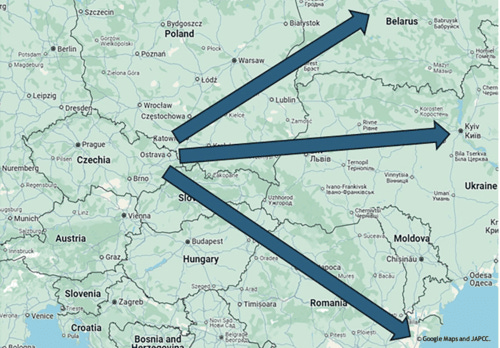NATO Needs An Extended Footprint in East Central Europe: The Case for Ostrava
By Glen E. Howard
Hi everyone,
I’m happy to announce an exciting new study I’ve written that was recently published by NATO’s Joint Air Power Competence Centre (JAPCC), offering a bold and timely vision for NATO’s future posture in East Central Europe. The piece explores a proposal that could have major implications for both strategic readiness and alliance cohesion: the creation of a NATO air base in Ostrava, Czech Republic. This isn’t just about building another runway—it’s about reshaping how and where NATO projects its airpower in an increasingly dangerous security environment that provides the Alliance with a new strategic window on the Carpathians and key parts of Ukraine.
The article describes the dramatically altered geopolitical landscape since Russia’s renewed invasion of Ukraine. NATO needs to rethink its deterrence and defense posture along its eastern flank. Historically, much of NATO’s infrastructure has been rooted in what the article calls “tidewater NATO”—countries like Belgium, Germany, and the Netherlands. These areas once served as command and logistics hubs, but they are now far removed from the regions most likely to see future conflict.
Enter the idea of “center field NATO,” a strategic concept that pushes NATO’s operational capacity eastward without overexposing key assets. Ostrava, located in eastern Czechia near the Slovak, Polish, and Hungarian borders, fits this concept perfectly. The article lays out a compelling case for why this site could become a new cornerstone of NATO’s presence in Central and Eastern Europe.
Ostrava’s Leoš Janáček Airport already offers a robust dual-use infrastructure. With a 2,450-meter runway, a maximum on-ground capacity (MOG) of 15–20 aircraft, and the ability to handle 50–70 flights per day, it can support everything from B-52 bombers to cargo and refueling aircraft. The airport is certified for military operations by the Czech Ministry of Defense and already hosts the annual NATO Days air show—the largest in Eastern Europe and often regarded as the regional equivalent of the UK’s Farnborough Airshow—making it both an operational and symbolic platform for transatlantic cooperation.
The article also highlights Ostrava’s strategic location. It sits along the Košice–Ostrava–Prague transport corridor, one of the busiest logistics networks in Europe. This gives it direct access to NATO’s eastern flank and complements the current logistics hub at Rzeszów-Jasionka Airport in Poland, which has played a critical role in supplying Ukraine. However, reliance on a single hub like Rzeszów carries risks. Developing Ostrava as a second gateway offers strategic redundancy, better resilience against Russian disruption, and operational depth.
A central theme of the article is how this proposal aligns with Czechia’s renewed commitment to NATO. Under President Petr Pavel, a former Chairman of the NATO Military Committee, Czechia has passed legislation to meet the alliance’s 2% GDP defense spending target and has launched a $7.5 billion program to acquire F-35 fighter jets. Although these aircraft will be based at Čáslav, Ostrava could become a crucial forward operating and logistics node, especially in the event of regional crises.
Establishing a NATO base in Ostrava would also offer powerful political and economic signals. It would reward a mid-sized ally stepping up its defense commitments, redistribute alliance responsibilities, and help revitalize a post-industrial region in need of long-term investment.
Below are a few specific reasons why Ostrava makes sense:
· Strategically located near NATO’s eastern border with direct access to the Carpathians and Ukraine.
· Capable of hosting both tactical and strategic aircraft, including B52 Stratofortress bombers.
· Reinforces Czechia’s increasing military role and integration with NATO’s most advanced systems.
· Serves as a backup and complement to the new NATO logistical hub in Rzeszów, Poland, which supports US and NATO arms deliveries to Ukraine by diversifying NATO’s logistical vulnerability (90 percent of NATO’s arms deliveries to Ukraine go through Rzeszów).
· Can transform an underutilized civilian airport into a symbol of allied unity and resilience.
In sum, the article paints a picture of Ostrava as a potential “mini-Ramstein”—a forward-looking, politically strategic, and operationally vital base that strengthens NATO where it needs it most. If you’re interested in how airpower, alliance dynamics, and regional infrastructure intersect in the current security era, this is definitely a read worth your time. Here is a link to the full PDF of the article. For more information about the JAPCC please visit their website here.
Enjoy!
Thank you for your support! Please remember that The Saratoga Foundation is a non profit 501(c)(3) organization. Your donations are fully tax-deductible. If you seek to support The Saratoga Foundation you can make a one-time donation by clicking on the PayPal link below! Alternatively, you can also choose to subscribe on our website to support our work.
https://www.paypal.com/donate/?hosted_button_id=XFCZDX6YVTVKA
This Substack is reader-supported. To receive new posts and support my work, consider becoming a free or paid subscriber.



